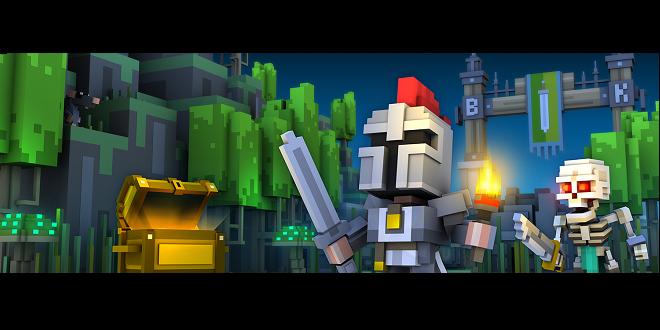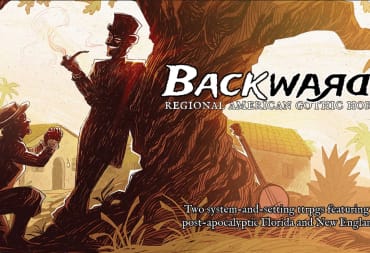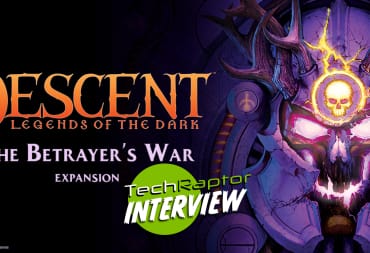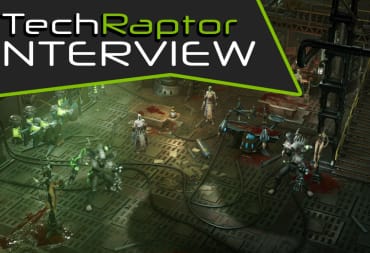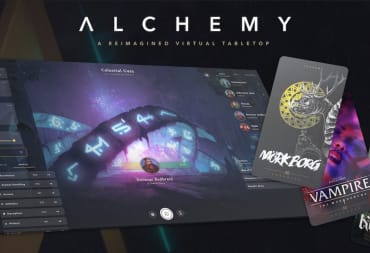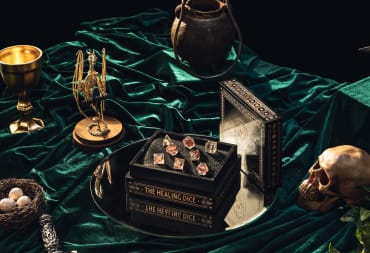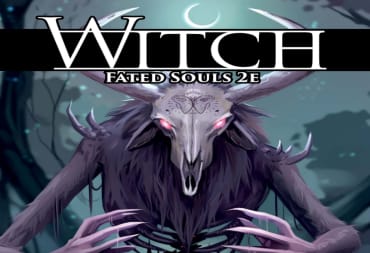AAA developers Scott Miller (Founder of 3D Realms) and Lee Perry (former lead designer on Gears of War) came together to create their own mobile game company called Dream Team. Dream Team’s first game, Boxy Kingdom, incorporates endless-hopper style movement with roguelike dungeon crawling and its own unique brand of combat. Boxy Kingdom is available on iOS as of April 28th and will be coming to Android shortly as a free-to-play game.
In all the excitement of the launch of Dream Team’s first game, the co-founders Scott Miller (SM) and Lee Perry (LP) took the time to answer some of TechRaptor’s questions about their new game Boxy Kingdom and how they applied their AAA experience to making a fun and polished mobile game.
TechRaptor: Boxy Kingdom is Dream Team’s first mobile game. Can you tell us about your development process?
SM: Head first swan dives! We’d come up with a myriad of ideas and the ones that worked stayed. Many others that were good were either fine-tuned to be great, or eventually tossed out like burnt steak. No one but my mother likes burnt steak.
But there was some process to the madness: We really tried to add gameplay ideas that would lead to emergent behaviors by enemies, and a lot of gameplay discoverability by players. As an example, we added braziers to the game, in case your torch went out (by a ghost touching you) you’d have a way to relight it. Hmmm, what if I could kick a brazier, let’s try that out? Oh cool, I can light other enemies on fire and kill them! But wait, what if I run into the fire? Let’s add water barrels that I can run into to put the fire out. How about if an enemy is on fire, it can also catch other enemies on fire that it runs into? Now this is getting fun! Let’s also add TNT crates that will explode if an on-fire enemy runs by it! And those TNT explosions can knock other braziers flying and cause the chain reaction to continue!
Anyway, this is how we kept improving the game, but attaching basic ideas together to allow for emergent scenarios that are really cool, beneficial, and even dangerous! Imagine you’re running by a TNT crate, but an on-fire enemy runs into it from the other side...you’re going to be toast. But it’s all under your control: Do you kick that brazier to kill some enemies up ahead, or do you not risk all the possible consequences? This is the essence of good gameplay, giving the playing strategic decisions that have both pros and cons.
And Boxy Kingdom is full of such decisions, most that are not obvious until you’ve played for several hours, and with several of the heroes, many of which add their own unique gameplay twists and turns.
TechRaptor: You have a lot of experience making AAA titles for console and PC. Why the move to mobile?
LP: We’ve been avid mobile gamers like most people with smartphones these days. But what we’ve found is -- with some exceptions to be certain -- that the mobile space lacks a general level of polish and design consideration that we’ve been accustomed to through decades of AAA industry experience. We want to apply that level of discipline in game development to the more casual mobile space, and bring players a new category of high-quality but accessible mobile games. Boxy Kingdom is our first foray into that effort.
TechRaptor: What does your AAA experience on other platforms bring to mobile games and your upcoming title?
LP: A perfect example of this would be our new Backstabbing mechanic in Boxy Kingdom. We knew we wanted to expand on the core movement of Crossy Road (we <3 Crossy!), and for a dungeon crawler, that meant adding in combat systems. And what we’ve learned in the AAA console and PC space is that core movement and user experience is everything. Gears of War, for example, wasn’t the first game to use cover-combat systems. But we iterated and perfected that core movement and combat loop such that Gears became the de facto cover-combat game for a generation of console gaming. Nothing else compared to how good 3rd person cover combat felt in that game.
The combat in Boxy Kingdom used to be more complex. It was that discipline in design that enabled us to drill down to an utterly simple combat mechanic that is tight, intuitive, and accessible. Our combat system ensures players don’t fall into bad habits like “kiting” enemies, and allows us to keep the platforming/strategy/puzzling mechanics that were so addicting in Crossy Road should players opt to just circumnavigate around enemies rather than engaging with them.
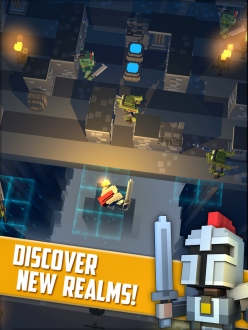
TechRaptor: What were your inspirations in creating Boxy Kingdom?
SM: Certainly Crossy Road. We really respected the simplicity in core movement the Hipster Whale guys went with. They took a classic game like Frogger, and made it super intuitive and addicting for the mobile audience.
The most obvious other inspiration would be Rogue and Rogue-like games. While designing moment-to-moment interactions we wanted a variety of objects you can interact with that make each play through different. We want players to always see new things, especially due to system interaction: "Holy crap, I lit that enemy on fire and as he was burning and running away he was hit by a mine cart."
TechRaptor: Boxy Kingdom has gameplay elements similar to Frogger or Crossy Road, how did you incorporate that style of play into a more complex game?
LP: While Boxy Kingdom is the first game in its category to have Backstabbing as the core combat mechanic, we preserved the platforming nature of Frogger that Crossy Road so elegantly simplified. You’re still tapping to move, and can as easily put up high scores without killing a single enemy. In fact, in Speed Run mode, it generally behooves you not to waste valuable time killing enemies.
I posed this same question to Human Head’s Chris Reinhart, who has a far more detailed answer!
Chris Reinhart: It certainly was inspired by Crossy Road. The lava logs and the mine carts were certainly nods to Crossy. However, we wanted Boxy to have many more interactive elements, hence the inspiration from Rogue-like games. We prototyped a ton of gameplay objects and enemy types, most of which made it into the final product. A few had to get cut due to not being very fun, and some were promising but we decided to wait until a future update to explore them.
Many of the ideas came from playing the game and brainstorming new ideas. The drawbridge came about when I wanted to find a way to get more verticality into the game. At the same time I was looking for some additional systems to slow the player down in a non-frustrating way. I prototyped a quick drawbridge and it worked great -- the player has to find a pressure plate (not too hard to find, but often you have to deal with enemies before you can press it!) and then lower the bridge to continue.
That lead to other cool ideas -- what if the bridge could crush enemies? Can enemies trigger the bridge (tested but rejected as it's more fun for the player to activate it rather than encounter a bridge that's already lowered).
Some ideas evolved into others. For example, I build a system that allowed for fluid propagation through cells. My original idea was a trap that would spread lava through the level and the player has to quickly rush forward to avoid getting killed by the lava. It looked really cool and was tense, but it wasn't something we could do all over the place. Later, I realized we could use this same tech on the braziers and spread fire instead of lava.
That tech is also used for the Guardian Dragon fire, poison gas (from poisonous mushrooms), and on the Blob creature (whoa rapidly multiplies, eating anything in its way).
TechRaptor: You worked with Crossy Road developer Hipster Whale in the process of perfecting the game. How did they contribute to the project and what was the collaboration process like?
SM: Working with Hipster was incredible. We really dig their Crossy games (check out Disney Crossy Road if you haven’t already, so much great content!) -- Matt and the team were able to help us avoid some pitfalls that they encountered through the development of Crossy and offered some really valuable feedback that helped on gameplay iteration.
But what I’d say they helped most with for a new mobile publisher like us was aiding in our understanding of bringing new IP to market on mobile. At the end of the day, all the AAA industry acumen in the world isn’t going to prepare you for mobile publishing. It’s a completely different beast altogether!
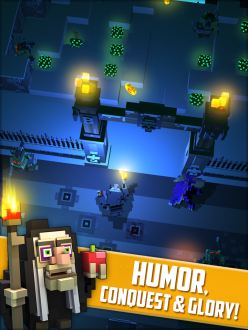
TechRaptor: How did you blend the different styles of gameplay in Boxy Kingdom?
SM: The game started off in a very simple state, taking advantage of the absolutely brilliantly intuitive controls of Crossy Road (tap to go North, swipe to go East, West or South), melded with the new idea of being able to attack enemies in the environment. We did not want an attack button, so we had the idea of an auto-attack, but it would ONLY work from behind the enemy. This proved to be an intensely satisfying game mechanic that we called Backstabbing. It meant that enemies were dangerous from their sides or head-on, so from behind them was the only safe way to attack. But what can make this hard is you need to attack before they hit a wall and turn! To make things easier, we highlight the enemy with red to show it’s within attack range, and we slow down its walking speed while it’s within range.
None of the dangerous enemies purposely seek you out, they basically go about their patterns. But when you have several on the screen at once that’s when it gets hairy. This style of gameplay goes way back to the Atari arcade game, Centipede, in which no single enemy type is hard on its own. But when the screen has centipedes, falling fleas, and a bouncing spider, it’s the combination that makes the game challenging. And we made Boxy Kingdom with that EXACT same design approach.
TechRaptor: The fun boxy graphics of the game may mislead some into thinking it’s simple. How is Boxy Kingdom a complex and challenging game?
LP: That’s the beauty of Boxy Kingdom. It *is* really that simple and intuitive. If you’re looking for an easy to pick-up platform puzzler akin to Crossy, you’re going to have a blast in Boxy. But if you decide to venture deeper -- and a lot of this will just be discovered organically whether you’re aiming for it or not -- you’ll uncover a depth and breadth of content that rivals most hardcore mobile experiences. We like to think we’ve made a premium AAA polished mobile game, with the accessibility and intuitiveness of a mass-casual free-to-play game.
TechRaptor: The backstabbing attack is a unique mechanic for the game. How do you think it’s inclusion adds strategy to gameplay?
SM: Most directly, backstabbing is valuable to the player as it delays the appearance of the Guardian Dragon. Generally, he’s always about 10 seconds behind the player. So if they spend too much time in a single area, it’s going to catch up to you and kill you. Moving North obviously delays its arrival. But, for every coin you collect, it also delays the dragon a bit. So if there’s a particularly cluttered area that you deem to be too hazardous to try to sprint through, you may decide to take your time picking off enemies around the edges before crossing, collecting coins along the way.
LP: Players have to learn how the enemies behave and then figure out the best way to attack those enemies. All enemies have fairly simple movement and attack patterns, but in conjunction with other enemies and environmental hazards the situations can get quite complex and really interesting as the player has to constantly figure out how to get behind enemies to defeat them. Careful players can take their time and sneak behind enemies and more adventurous skillful players can rush in and still have success.
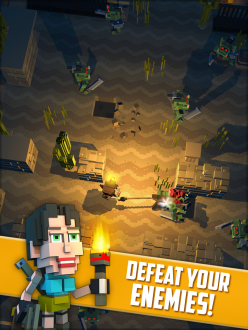
Does Boxy Kingdom have a storyline or is it all about the gameplay?
SM: Boxy Kingdom has a very light storyline -- it borrows from the classic games of Rogue and NetHack. The objective in those games are to enter the dungeon and get to the bottom level to find a magical amulet. Boxy starts with the hero finding that amulet and trying to escape. But in Boxy, the player inadvertently woke up a dragon guarding that amulet… And of course, as an infinite scrolling game, there is ultimately no escape ;)
TechRaptor: There are over 30 heroes with different themes and attacks included in the game. Any plans to add more heroes in the future? Do you have a favorite?
LP: We’re launching with 35 heroes, which is just an incredible amount of content. Most of which change the gameplay either in small, or drastic ways. Lord Chaos, for example, is one of our most powerful heroes. His chain-lightning attacks don’t actually lunge toward the enemy when you backstab them, and they also chain to any surrounding enemies killing them as well. Which is fundamentally different than Killer, the Monty Python inspired bunny rabbit that can chain-jump its attacks in rapid succession and across gaps and other hazards. Unlocking additional heroes will be a delightful experience for players, but you’ll notice it doesn’t disrupt the core combat mechanic one bit. The learning curve to mastering new heroes is super intuitive. Whether you’re playing a more ranged or melee hero, your core movement and combat mechanics are all the same.
And yes, we’ll be adding more with game updates!
TechRaptor: What type of leveling process does the game use for heroes? How does it affect the game?
SM: Heroes gain experience by attacking and moving North. Each time a hero levels up you gain heart gems and coins. When a hero reaches level 10 they gain the ability to attack one unit farther, which is extremely useful. At level 20, heroes gain another really useful ability, but you'll have to play the game to find that one out!
TechRaptor: Is there any multiplayer mode or interaction between players in Boxy Kingdom?
SM: No multiplayer in Boxy Kingdom. We really wanted to get the solo experience feeling right. But we haven’t ruled it out for the future!
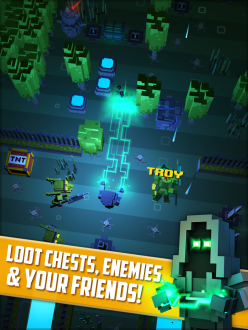
TechRaptor: What are your feelings on the current state of the mobile game market? What is your game bringing to the platform?
SM: Some claim the mobile market to be in decline, or over-saturated with games. We think of the problem a little differently. There’s just so much content for players to choose from, and some of it is a bit sloppy. But one thing is clear -- quality content shines, and players can perceive in very tangible ways the difference between quality content and rushed content. Our experience in the AAA space has taught us the discipline to stand up extremely efficient and high-quality development pipelines and methods that, when applied to the mobile games space, allows us to rapidly iterate on designs and systems that are simply FUN. The tiniest detail like maintaining the same mechanic for initiating combat (our Backstab mechanic) throughout all your heroes makes a profound difference on overall player experience. Players may not be able to articulate why the combat in Boxy Kingdom feels so much better than the combat of other dungeon crawlers on mobile, but they certainly know what feels the best.
TechRaptor: Do you have any thoughts on premium vs. free-to-play games? What decisions went into making Boxy Kingdom free?
LP: Going free just allows so many more people to experience your game than otherwise would have. And for a game like Boxy which is made better with the more content, enemies, and heroes -- free-to-play just made perfect sense. I think there’s definitely room for both, and you shouldn’t set out to make a game one way or the other. Developers should set out to make great games, and then decide which monetization method is proportional to the value you’re delivering players. If we made Boxy Kingdom premium, for example, how are we supposed to price that? Do we price it at the value of every piece of content in the game? But what about people who only want to play 3 or 4 Heroes ever? They’d sort of feel ripped off. These were the thought processes we think all developers should have at some point during development.
TechRaptor: Is there anything else you’d like to share about Boxy Kingdom?
SM: We think we’ve created a game that mixes new school and old school in a very fun and unique way. Yes, we were inspired by the brilliance of Crossy Road, but we’ve added so much to the formula, especially with the ability to attack, leveling up, quests, and the many special abilities of the various heroes. And we have more Boxy games on the way, with entirely new themes. And of course we plan to release numerous updates for Boxy Kingdom, with new heroes, new environments, and new play modes.
A big thank you to the Dream Team for taking the time to answer our questions and sharing their insight with our readers.
Have a tip, or want to point out something we missed? Leave a Comment or e-mail us at tips@techraptor.net
